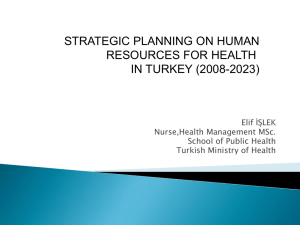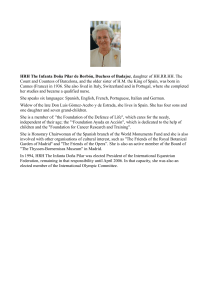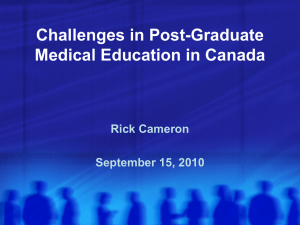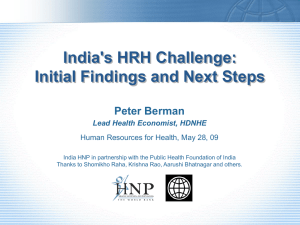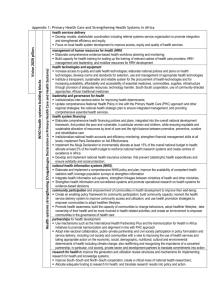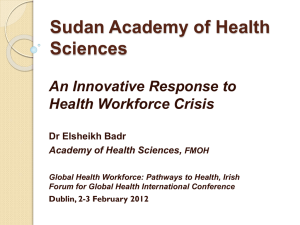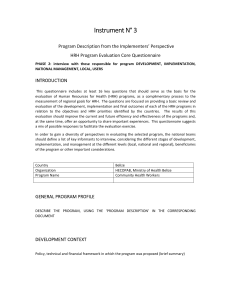An approach to estimating human resource requirements
advertisement
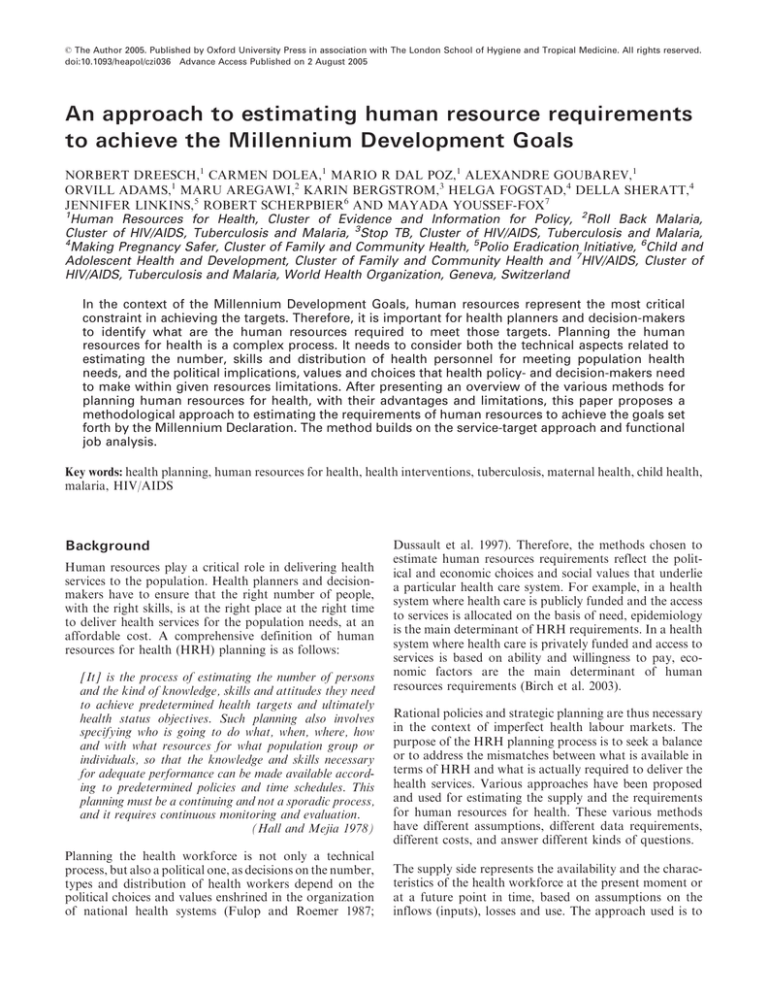
ß The Author 2005. Published by Oxford University Press in association with The London School of Hygiene and Tropical Medicine. All rights reserved. doi:10.1093/heapol/czi036 Advance Access Published on 2 August 2005 An approach to estimating human resource requirements to achieve the Millennium Development Goals NORBERT DREESCH,1 CARMEN DOLEA,1 MARIO R DAL POZ,1 ALEXANDRE GOUBAREV,1 ORVILL ADAMS,1 MARU AREGAWI,2 KARIN BERGSTROM,3 HELGA FOGSTAD,4 DELLA SHERATT,4 JENNIFER LINKINS,5 ROBERT SCHERPBIER6 AND MAYADA YOUSSEF-FOX7 1 Human Resources for Health, Cluster of Evidence and Information for Policy, 2Roll Back Malaria, Cluster of HIV/AIDS, Tuberculosis and Malaria, 3Stop TB, Cluster of HIV/AIDS, Tuberculosis and Malaria, 4 Making Pregnancy Safer, Cluster of Family and Community Health, 5Polio Eradication Initiative, 6Child and Adolescent Health and Development, Cluster of Family and Community Health and 7HIV/AIDS, Cluster of HIV/AIDS, Tuberculosis and Malaria, World Health Organization, Geneva, Switzerland In the context of the Millennium Development Goals, human resources represent the most critical constraint in achieving the targets. Therefore, it is important for health planners and decision-makers to identify what are the human resources required to meet those targets. Planning the human resources for health is a complex process. It needs to consider both the technical aspects related to estimating the number, skills and distribution of health personnel for meeting population health needs, and the political implications, values and choices that health policy- and decision-makers need to make within given resources limitations. After presenting an overview of the various methods for planning human resources for health, with their advantages and limitations, this paper proposes a methodological approach to estimating the requirements of human resources to achieve the goals set forth by the Millennium Declaration. The method builds on the service-target approach and functional job analysis. Key words: health planning, human resources for health, health interventions, tuberculosis, maternal health, child health, malaria, HIV/AIDS Background Human resources play a critical role in delivering health services to the population. Health planners and decisionmakers have to ensure that the right number of people, with the right skills, is at the right place at the right time to deliver health services for the population needs, at an affordable cost. A comprehensive definition of human resources for health (HRH) planning is as follows: [It] is the process of estimating the number of persons and the kind of knowledge, skills and attitudes they need to achieve predetermined health targets and ultimately health status objectives. Such planning also involves specifying who is going to do what, when, where, how and with what resources for what population group or individuals, so that the knowledge and skills necessary for adequate performance can be made available according to predetermined policies and time schedules. This planning must be a continuing and not a sporadic process, and it requires continuous monitoring and evaluation. (Hall and Mejia 1978) Planning the health workforce is not only a technical process, but also a political one, as decisions on the number, types and distribution of health workers depend on the political choices and values enshrined in the organization of national health systems (Fulop and Roemer 1987; Dussault et al. 1997). Therefore, the methods chosen to estimate human resources requirements reflect the political and economic choices and social values that underlie a particular health care system. For example, in a health system where health care is publicly funded and the access to services is allocated on the basis of need, epidemiology is the main determinant of HRH requirements. In a health system where health care is privately funded and access to services is based on ability and willingness to pay, economic factors are the main determinant of human resources requirements (Birch et al. 2003). Rational policies and strategic planning are thus necessary in the context of imperfect health labour markets. The purpose of the HRH planning process is to seek a balance or to address the mismatches between what is available in terms of HRH and what is actually required to deliver the health services. Various approaches have been proposed and used for estimating the supply and the requirements for human resources for health. These various methods have different assumptions, different data requirements, different costs, and answer different kinds of questions. The supply side represents the availability and the characteristics of the health workforce at the present moment or at a future point in time, based on assumptions on the inflows (inputs), losses and use. The approach used is to 268 Norbert Dreesch et al. assess the availability of human resources (‘active supply’) as the difference between future increments (from new graduates, transfers from other occupations, immigration) and projected losses (through deaths, retirements, emigration, transfer to other occupations, and ‘inactive supply’, usually unemployed health workers). It usually requires extensive data collection and assumptions on attrition rates, both from training institutions and the health system (Hall and Mejia 1978). To estimate the HRH requirements, four methods have been traditionally described: needs-based approaches, utilization or demand-based approaches, health workforce to population ratios, and the target-setting approach (Hall and Mejia 1978; Markham and Birch 1997). Table 1 presents the advantages and limitations of these methods as well as those of the approach proposed in this paper. With the exception of the health workforce to population ratios approach, these methods seek to translate the required number and types of health services into time estimates, and then express these as full-time equivalents of health personnel, using norms and standards on the actual productive time. The difference between these methods resides in the way in which the required health services are identified. For instance, in the needs-based approach, the number and type of health services to be delivered are estimated based on the health needs of the population, assuming that all health needs can and should be met, and using professional judgments on what are the most appropriate services and technologies to meet those needs. However, this approach does not take account of users’ perspectives based on their values, culture and traditions. Neither does it take into account the different perceptions of patient/client need as viewed by the various types of health workers, who all may hold vastly different perceptions based on their values, traditions and professional judgments. In the target-setting approach, the number and types of services are set by health authorities as specific targets, at various levels of care, considering the current level of technology, the demand of the population for certain services and the various services already performed by health workers. The utilization-based approach usually takes the current level of health services utilization as being appropriate to meet the health needs and projects the future requirements of the health workforce based on future changes in the structure of the population (Hall and Mejia 1978; Hornby et al. 1980). Once the number and types of services have been identified, translating them into time requirements can be done in two ways. One way is by using professional judgments or expert opinions on the expected time required to deliver specific health interventions. For example, a panel of experts (the Delphi technique) is asked to make assumptions on what is the time required to deliver specific health interventions, given specific technological resources and at various levels of care, by various professional categories. Another way is to actually measure the time taken to deliver specific services through time-motion studies, patient flow analysis or activity sampling techniques (WHO 2001). There are many methodological limitations to these approaches for HRH planning at country level. Most of the time HRH planning is seen as an isolated technical process, not linked with national health policy, the health needs of the population or health outcomes. Often HRH planners and decision-makers do not have adequate data on which to base their decisions, and there is too much emphasis on quantitative aspects, with too little on the qualitative. Planning is most often profession-specific, considering only one or two of the health professions, usually doctors and nurses. It does not consider teams and ignores the variations in practice and the possibility of using substitute health workers, or changing the current level of productivity. Usually these methods do not consider the level of resources committed to health care and other economic aspects, and the assumptions they use need to be evaluated for relevance and accuracy (O’Brien-Pallas et al. 2001a; Murphy 2002). Further detailed methodological discussion and policy considerations on planning approaches have been proposed in the literature, although they do not specifically address the developing country context (Bloor and Maynard 2003). Various authors have proposed adaptations and amendments of these methods to overcome these shortcomings (Adams and Wood 1990; O’Brien-Pallas et al. 2001b; Birch et al. 2003; Kurowski et al. 2003). The adjusted service target approach was proposed by Adams and Wood (1990) to estimate physician requirements for Canada. The model attempted to establish appropriate service targets by critically examining the current levels of services and adjusting to reflect expert opinion on the methods by which they are delivered. In effect, it uses utilization data, adjusted to reflect expert opinion on norms of care, within a known environment. However, the model only addressed physicians’ requirements, without looking at the potential substitution between health professions. Another approach, called NTTP (needs, service targets, time and productivity), was proposed to estimate the human resources requirements to deliver health interventions related to the Millennium Development Goals (Kurowski et al. 2003). The quantity of services was estimated for 33 priority health interventions recommended by the Commission on Macroeconomics and Health, which were advocated to address the disease burden attributable to tuberculosis, malaria, childhood disease, maternity-related conditions and HIV/AIDS. This method is very close to the approach presented here, the difference being in the way the interventions are identified and in the way time estimates are elicited. The World Health Organization (WHO) proposed ‘coordinated health and human resources development’ Estimates future requirements based on current level of service utilization in relation to future projections of demographic profiles Utilization-based (or demand-based) Sets targets for the production and delivery of specific outcome oriented health services Converts these targets into HRH requirements by means of staffing and productivity standards Identifies service needs based on epidemiological and demographic profile, and programmatic targets Identifies tasks and skills required to deliver the evidence-based strategic interventions for the specific programs, based on functional job analysis Estimates time requirements for each intervention, based on time-motion studies or expert opinion Translates the time requirements into adjusted full-time equivalents, based on productivity Effective evidence-based interventions can be delivered in all settings/conditions It assumes that the standards of each service covered are practicable and can be achieved within the timescale of the projection Source: Hall and Mejia (1978), Markham and Birch (1997), O’Brien-Pallas et al. (2001a). Adjusted service target approach Service target-based Health workforce Specifies desired worker-toto population ratio population ratio All health care needs can and should be met Cost-effective methods to address the needs can be identified and implemented Resources are used in accordance with needs Estimates future requirements based on estimated health deficits of the population Projects age- and gender-specific ‘service needs’ based on service norms and morbidity trends Converts projected service needs to persons requirements using productivity norms and professional judgment Needs-based Current level, mix, distribution of health services are appropriate Age- and sex-specific requirements remain constant in the future Size and demographic profile of the population changes in ways predictable by observed trends in age- and sex-specific rates of mortality, fertility and migration Often based on current best region ratio or a reference country, with a similar but presumably more developed health sector Assumptions Method for estimating Description HRH requirements Table 1. Approaches used to estimate requirements for human resources for health Useful for specific programmes Looks at efficiency issues and potential for combination of skills Useful to identify training needs Goes beyond the traditional occupation-based training/practice towards competency-based training and service Relatively easy and understandable Can assess interactions between variables Quick, easy to apply and to understand Has the potential of addressing the health needs of the population using a mix of HRH Is independent of the current health service utilization Is logical, consistent with professional ethics, easy to understand Is useful for some programmes such as prenatal and child care Is useful for advocacy Economically feasible targets due to no or little change in population-specific utilization rates (assumed) Advantages Requires detailed workflow studies or expert assessment and opinion Can only be effective if infrastructure, supplies and logistics are in place to support HRH Provides no insight into personnel utilization Does not allow to explore interactions between numbers, mix, distribution, productivity and outcome Base year maldistribution will likely continue in target year Potentially unrealistic assumptions Requires extensive data Overlooks the consequences of ‘errors’ arising from the assumptions proving to be invalid Produces a ‘status quo’ projection, since future population segments are assumed to have similar utilization rates as base year segments Ignores the question of efficiency in allocation of resources among other sectors Requires extensive data If technology changes, it requires norms update Is likely to project unattainable service and staff targets Limitations Human resources requirements for the MDGs 269 270 Norbert Dreesch et al. as a more comprehensive and systematic approach for health systems and human resource development (WHO 1990). The approach proposed fundamental changes in the philosophy of planning towards interdisciplinary and intersectoral planning. However, the shift was very difficult to transfer from theory into practice, particularly in the context of public and health sector reforms (IHHRDP 1995). Public sector reform drives during the 1990s were characterized by a focus on implementing stringent fiscal reforms, often resulting in public sector hiring freezes. At the same time, more pluralist health systems emerged, with a lack of stewardship exercised towards the development of a balanced health workforce. There is a perceived need today to use a combination of quantitative and qualitative methods and techniques, as well as managerial and economic approaches, which will contribute to a better integration and coordination of human resources planning in national health planning and policy development. chemotherapy under proper case-management conditions, including directly observed treatment; regular drug supply; and a standardized recording and reporting system that allows assessment of individual patients as well as overall programme performance (WHO 1999). However, many countries have failed to achieve the global targets of detection (70% of infection cases) and of cure (85% of those detected) by the year 2000, citing human resource constraints as a major bottleneck (Bergstrom 2002; WHO 2003). Overall, it is estimated that less than 27% of the world’s active TB cases are under DOTS care (WHO 2003). Malaria causes at least 300 million cases of acute illness each year, and is the leading cause of death in young children. Pregnant women are the main adult risk group in most endemic areas of the world. Each year, around 90% of the more than 1 million deaths from malaria worldwide occur in Africa; this constitutes 10% of the continent’s overall disease burden (WHO and UNICEF 2003). The Millennium Development Goals In the context of the Millennium Development Goals (MDGs), human resources for health pose a new challenge for health policy- and decision-makers in countries, and the question of having the right number, the right skills and the right distribution of health workers to meet the MDGs is one that many governments are struggling with. Three of the eight MDGs address health issues and aim at reducing child mortality, improving maternal health, and combating HIV/AIDS, malaria and other diseases (United Nations 2000). The burden of each of the health problems addressed by the MDGs is well known. The HIV/AIDS pandemic continues to spread unabated in many parts of the world, although some countries have shown that political leadership and concerted action by all sectors of society can lead to tangible progress. The goal of covering 3 million people suffering from HIV/AIDS with antiretroviral therapy (ART) by the year 2005 was proposed at the International AIDS Conference held in Barcelona in July 2002. It was also embraced by WHO, and declared one of the major priorities of action by the newly appointed WHO Director General, Dr JW Lee, in 2003 (Lee 2003). Tuberculosis (TB) has re-emerged as a major cause of death and disability in many countries, and the development of multidrug-resistant strains has complicated its clinical management. The WHO-recommended TB-control strategy known as DOTS is a cost-effective combination of technical and managerial components, which has proved successful in large and small countries, both rich and poor, in the treatment of tuberculosis. The five elements of the DOTS strategy, considered essential for global TB control, are: political commitment; case detection using sputum microscopy among persons seeking care for prolonged cough; standardized short-course The Integrated Management of Childhood Illness (IMCI) strategy targets children for specific interventions that have the potential to reduce the most important causes of childhood mortality (pneumonia, diarrhoea, malaria, measles, HIV/AIDS, neonatal causes and malnutrition) (Gove 1997; Tulloch 1999). Children under five bear 19% of the total global mortality (Mathers et al. 2002), and nearly all deaths (97%) occur in poor developing countries (Mathers et al. 2003). A limited set of evidence-based interventions, including those contained within IMCI, could prevent two-thirds of mortality by 2015, and thus help reach the MDG related to child mortality (Jones et al. 2003). However, efforts to attain universal coverage with these interventions need to be stepped up substantially. This requires reaching out to communities (Bryce et al. 2003) and addressing financial as well as human resource barriers (Bellagio Study Group on Child Survival 2003). The ‘Making Pregnancy Safer’ initiative is promoting strategies to ensure skilled care is provided to all pregnant women, women in childbirth and newborns in order to reduce maternal and perinatal mortality and morbidity. Every year approximately 8 million women world-wide endure pregnancy-related complications and over half a million die as a result; some 3.9 million newborn babies die during their first week of life and another 3 million are born dead (WHO, UNICEF and UNFPA 2004). One of the key interventions to reduce the burden of maternal and newborn morbidity and mortality is to ensure that births are attended by skilled health workers, who are accredited health professionals such as midwife, doctor or nurse, who have been educated and trained to proficiency in the skills needed to manage normal (uncomplicated) pregnancies, childbirth and the immediate postnatal period, and in the identification, management and referral of complications in women and newborns (WHO 2004). Human resources requirements for the MDGs Strategies and constraints to implementation The global strategies that each programme at WHO proposed to address these challenges have several elements in common; for example, the strong dependency on human resources; the need for strong surveillance and monitoring systems; the requirement for accessible and affordable drug supply; the focus on prevention; and the need for programmes for particular target groups and emergency situations (WHO and UNICEF 1999; WHO 1999, 2002b, 2002a). The actual implementation of these strategies faces several constraints, spanning a range from weak political commitment and financial constraints, through to managerial and organizational weaknesses, lack of a primary health care infrastructure and limited access to drugs. However, the major constraint that each of the specific programmes has noticed in the implementation of their strategies relates to human resources for health. For example, a study commissioned by the Global Alliance for Vaccines and Immunization (GAVI) found that management and human resources represent a major constraint in 40 Vaccine Fund-eligible countries, in 18 being the primary barrier for immunization scale-up (McKinsey Group 2003). The annual review of the STOP TB programme found that 10 of the 22 high burden countries reported major deficiencies in staffing at central level, while another seven countries struggle with inadequately trained staff at periphery level (WHO 2003). Reviews of the implementation of IMCI noted human resource barriers as critical health system constraints and recommended that, in order to achieve the under-five targets of the MDGs, countries and implementing partners urgently needed to increase and make better use of the existing human and financial resources devoted to child health programmes (WHO 2002b; DfID et al. 2003). The main HRH constraints to deliver priority health interventions are: inadequate number of health staff due to low financial resources; uneven distribution of health workers at different levels; high attrition and low replacement rates; inappropriate or inadequate training with curricula that are not needs-based; poor policies and practices for human resources development (poor career structures, working conditions and remuneration); high staff turnover; lack of supportive supervision; lack of integration with the private sector; poor access to information and knowledge resources; and low morale and motivation. In the following section we provide a method to estimate the human resources requirements to achieve the MDGs, 271 as one step towards addressing the above concerns. The method builds on the service target approach and the functional job analysis, and seeks to identify skills and time requirements, as well as potential efficiency gains across various priority health programmes. An approach to estimating HRH requirements to achieve the MDGs An inter-cluster collaborative working group within WHO is working towards developing a methodology to estimate the HRH requirements for priority health interventions. The approach involves the following steps: (1) (2) (3) (4) (5) (6) Identify the needs for services, based on the incidence and prevalence of health problems, demographic characteristics of the population, and (internationally) the targets set forth by the MDGs, or (at country level) targets identified in health sector strategic plans. Identify the interventions required to deliver these services, at each level of care, based on the strategies proposed by various programmes. Identify the tasks and skills required to deliver those specific interventions, at each level of care, using a functional job analysis. Estimate the time requirements for each of the interventions, at each level of care, based on programme expert opinion or data provided by time-motion studies; express time requirements in full-time equivalents. Identify possible overlap/synergies between skills and possible time-savings effected by combining various skills; build in productivity. Estimate adjusted full-time equivalents. Figure 1 presents schematically the adjusted service targets approach for estimating the human resources requirements for priority health problems. The framework builds on the functional job analysis or task analysis (Moore 1999). A task is defined as a unit of work which can be described in a task statement, which answers the following questions: who performs what action, to whom or what, upon what instructions or sources of information, using what tools, equipment or work aids, in order to produce what output. The task analysis seeks to define and describe the knowledge, skills and abilities (KSA) involved in a job. These KSA serve to specify both what is required by the job and the health worker qualifications for the job. KSA are the essential information needed by organizations for carrying out their diverse HRH functions and can provide an excellent basis for estimating personnel requirements. A matrix has been developed, in which the various programmes can list the tasks that need to be performed at various levels of care (Figure 2). The levels of care and the task categories are listed in Table 2. Using this matrix, each programme can identify the skills required to deliver 272 Norbert Dreesch et al. Evidence-based health interventions Service targets Demographics Tasks Needs Incidence and prevalence of diseases Skills required Training needs Time requirements HRH requirements (FTE) Productivity/ efficiency gains Figure 1. Adjusted service target approach for HRH planning EPI/Polio/HIV/AIDS/Malaria/StopTB/MMPR/IMCI Level of Intervention National programme office Task category Tasks to be performed Skills required Training programme needs Time required Productivity efficiency gains Programme management Prevention Diagnosis Treatment Counselling Drug procurement Data management Surveillance Action for social behavioural change Others Sub-national/ Provincial " District health office " Hospital Health centre Other lower health facilities " " " Community level activities " Figure 2. A matrix for task analysis across various health problems their interventions, at each level of care, as well as the training needs, which in this case refer to the additional in-service training required from the perspective of each programme, based on the case management tasks identified. Pre-service training is not considered here, as this is taken as a prerequisite and does not consume time from the health worker on the job. Nevertheless, the principles of functional job analysis are equally valid for Human resources requirements for the MDGs Table 2. Levels of care and task categories Levels of care national provincial/state district health office hospital health centre other lower health facility community-level activities Task category programme management prevention diagnosis treatment counselling pharmaceuticals surveillance data management action for social behaviour change 273 The process of getting from the listing of tasks and identification of skills/competencies to estimating the time requirements for all the programmes has been tested initially within the specific context of two countries (Ghana and Ethiopia). A first attempt to use this matrix has been made from the perspective of one programme (Roll Back Malaria); the exercise emphasized the importance of contextual factors in defining skills and competencies, at the national strategic level (Marsden et al. 2003). Discussion pre-service training. Time requirements to deliver the tasks listed, as well as to participate in in-service training, will form the total amount of time required by health workers to deliver quality interventions. Then, across the matrix, it is possible to identify potential overlaps and synergies between various programmes. In listing the various administrative, managerial and operational tasks across distinct system levels, e.g. national, provincial and health centre, it will be possible to see whether skills can be combined, synergies be derived in other ways, and which alternatives countries may choose to locate specific tasks and functions at distinct operational levels. Also, at the training levels, it is possible to identify a core set of skills, common to all priority programmes, such as communication skills or supervisory skills, that can be taught in one single course. On the other hand, it is also known that health staff delivering first-line services are usually enrolled for the training courses of all priority programmes, sometimes for long periods of time, impacting on the regular delivery of services. Identifying the training needs for each of these programmes at various levels of care is a pre-requisite for a more efficient organization and planning of the training sessions. The time requirements for delivering the tasks can be elicited through either expert opinion or field observation (time and motion studies, patient flow analysis, activity sampling technique) (Hurst 2002). In the approach used here, the time estimates proposed by each specific programme, as they are observed in the literature and confirmed by programme staff/experts, are then translated into full-time equivalents, expressing the human resources required for these tasks at each level of care. It has to be recognized, however, that the total number of full-time equivalents for specific coverage goals does not translate directly into a number of new staff members to be trained, but gives an order of magnitude on the amount of staff working time needed to achieve the goals. As existing staff already perform a multitude of functions, inclusive of covering some of the tasks requested by MDGs, local adjustment will have to be made in order to quantify additional need correctly. The difference between the current availability of staff and the HRH requirements estimated using the ‘benchmark’ time estimates would represent the HRH gap. There are a number of reasons for choosing this particular approach in planning for HRH requirements: the MDGs set specific objectives for health and there are a number of specific interventions to achieve these objectives, when delivered to the population in need. It is also possible to set service targets based on these interventions. The functional job analysis allows for clearly identifying the skills required to deliver specific tasks, and for identifying potential synergies and time savings across specific interventions. The data required for this exercise are not very complex, and the involvement of the actual providers in estimating the time requirements gives the approach a participatory nature, which is absent in all the other approaches for HRH planning. However, several limitations need to be considered when using the approach proposed here. There are technical difficulties in some settings to actually define the tasks that need to be performed, and often the skills required do not match with those existing. When timing the various tasks at various levels, there is a danger of over-estimating the requirements by adding up apparently small differences observed at lower levels of care. Then, in terms of planning, the exercise should consider the feasibility of getting the estimated number of staff, given the available resources. While this method only focuses on the priority health problems related to the MDGs specifically in the developing country context, the approach could be extended to other health problems that are considered priorities for a given country at a given moment in time. In attempting to integrate human resources planning across health priority programmes, it will be necessary to analyze three questions: why to integrate, what to integrate, and at what level of care. It is important to understand that by integrating some of the tasks performed by various staff for various health interventions, it is possible to achieve efficiency gains. It is, however, equally important to identify the various functions that need to be integrated, like deployment, planning, supervision, service delivery. Finally, some of these functions could be better performed at central level, while others could be delivered using a horizontal approach at the local level. The nature of the tasks within each category varies per level. For example, at central level the task related to diagnosis may be to set diagnostic standards and to 274 Norbert Dreesch et al. determine and ensure equipment needs, whereas at health centre level it may be more related to the diagnostic process itself. However, such a change has many implications. Policies and the legal framework governing the authority for certain categories of staff to provide specific interventions may need to be reviewed and amended. This is not an easy process, since it implies dealing with social values and professional boundaries, as well as negotiating to define and agree upon new roles. Moreover, these new roles, authorities and functions must be negotiated in such a way as to gain social acceptance. Inevitably, this will require public debate and discourse, and often considerable advocacy for society to accept such change. current level of HRH is simply not enough to achieve the targets, despite increased investment in education (absolute shortage, or gap). For other countries, targets can be achieved through a combination of increasing investment in education for health professions and a more efficient use of existing HRH (relative shortage, or need). Therefore, a simple methodology for assessing the current HRH availability and for estimating the future requirements of HRH, based on health needs and targets of the MDGs, would be a helpful tool for developing countries to plan their health workforce. While concentration of effort leads to relatively rapid results during the first phases, the final coverage goals of a priority programme can often only be achieved by combining forces with other supportive programme interventions and use of multi-skilled health workers. Therefore, combining and/or expanding skills throughout a sub-set of purpose trained health workers may be a solution to increase effectiveness of the programme implementation. The engagement of the private sector, both for-profit and not-for-profit (faith-based or charitable NGOs), is another issue that needs to be considered in the attempt to integrate human resources for priority health problems. Traditionally, several methods for HRH planning have been used, ranging from health workforce to population ratios to standard staffing norms for individual health facilities. Different methods have addressed the supply side of the health workforce, the demand side, or both. These methods have largely failed to recognize the effects of shared competencies, the potential of substitution between health professions and the multiple tasks performed by a particular category of provider (Birch et al. 2003). These approaches to addressing workforce imbalances, attrition rates and population changes may still be useful for country-level planning. However, new thinking is required for the emerging context of health care. HRH planning must adopt a more integrated approach and consider the potential of redistributing tasks between health professions, mobilizing the community and integrating external resources into national HRH planning. At country level, specific aspects of the organization and management of health systems will need to be considered when implementing such an approach. The planning of HRH for priority health interventions should not be performed at the expense of other health sector needs. A thorough investigation of the available resources for the planned human resources, as well as for the services they need to provide, will be the first and most important step of this approach. A sequence of proposed steps to follow is depicted in Figure 3. Towards integrated HRH planning One of the major limitations in applying this approach consistently is the lack of detailed data about the health workforce at country level. Countries that have the most need of resources in order to achieve the MDGs are also the ones which usually lack the information/data on the current level and distribution of their health workforce, and have a limited capacity to analyze and plan for future HRH. Also, for some countries, it may be the case that the HIV/AIDS • • • • • • • • TB Malaria MPS IMCI Polio/EPI Other priorities Selecting interventions and analysing time and current tasks Reviewing current HRH stock and distribution Gap analysis Redistributing tasks/activities across existing workforce, considering the role of community input to health care Identifying additional work force needs Mobilizing for HRH needs Building the health system infrastructure, facilities, logistics Integrating external resources into national health systems and HR planning Figure 3. Integrated cross-cutting HRH planning for priority health interventions Conclusions The method proposed here can be used as an alternative approach to the traditional health workforce planning methods. It builds and expands on existing tools, and responds to the ever greater need for reaching higher degrees of efficiencies in staff utilization, which is of prime importance to reach the MDGs. The approach adopted is to first conduct a gap analysis between what is required to achieve the tasks of each programme, in terms of health workforce, and what is actually available at country level. The results of this analysis could then be used, in particular in the developing countries’ context, for the elaboration of integrated sector-wide strategies. This would better respond to priority health problems and to human resources constraints resulting from competing programme objectives. It is expected that this will lead to a more balanced distribution of staff between priority programmes. This response will require changes in how elements of the workforce are trained and expected to work together to meet the changing needs of the health system. References Adams O, Wood A. 1990. Physician resource planning. The ‘‘adjusted service target approach’’. A suggested pilot project. Prepared for the Royal College of Physicians and Surgeons of Canada. Ottawa: Curry Adams & Associates, Inc. Bellagio Study Group on Child Survival. 2003. Knowledge into action for child survival. The Lancet 362: 323–7. Human resources requirements for the MDGs Bergstrom K. 2002. Training for better TB control: Human resource development for TB control – a strategic approach within country support. Geneva: World Health Organization, WHO/CDS/TB/ 2002.301. Birch S, O’Brien-Pallas L, Alksnis C, Murphy G, Thompson D. 2003. Beyond demographic change in human resources planning: an extended framework and application to nursing. Journal of Health Services Research and Policy 8: 225–9. Bloor K, Maynard A. 2003. Planning human resources in health care: towards an economic approach. An international comparative review. Ottawa: Canadian Health Services Research Foundation. Bryce J, el Arifeen S, Pariyo G et al. 2003. Reducing child mortality: can public health deliver? The Lancet 362: 159–64. DfID, UNICEF, USAID and WHO. 2003. The analytic review of the Integrated Management of Childhood Illness Strategy. Geneva: World Health Organization. Dussault G, Adams O, Fournier P. 1997. Human resources planning in health and population services. Instituto de Medicina Social. Universitade do estado de Rio de Janeiro. Serie ‘Estudos em Saude Colectiva’ 158. Fulop T, Roemer MI. 1987. Reviewing health manpower development. A method of improving national health systems. Public Health Papers no. 83. Geneva: World Health Organization. Gove S. 1997. Integrated management of childhood illness by outpatient health workers: technical basis and overview. The WHO Working Group on Guidelines for Integrated Management of the Sick Child. Bulletin of the World Health Organization 75 (Suppl. 1): 1–24. Hall T, Mejia A. 1978. Health manpower planning: principles, methods, issues. Geneva: World Health Organization. Hornby P, Ray DK, Shipp PJ, Hall TL. 1980. Guidelines for health manpower planning. Geneva: World Health Organization. Hurst K. 2002. Selecting and applying methods for estimating the size and mix of nursing teams. Systematic review of the literature commissioned by the Department of Health, April 2002. Leeds: Leeds University. IHHRDP. 1995. Integrated health human resources development: pragmatism or pie in the sky. National Framework. Ottawa: IHHRD Project. Jones G, Steketee RW, Black RE et al. 2003. How many child deaths can we prevent this year? The Lancet 362: 65–71. Kurowski C, Wyss K, Abdulla S, Yemadji N, Mills A. 2003. Human resources for health: requirements and availability in the context of scaling up priority interventions. Case studies from Tanzania and Chad. A report for the UK Department for International Development. London: Health Economics Financing Programme, London School of Hygiene and Tropical Medicine. Lee J. 2003. Speech to the Fifty-sixth World Health Assembly. Geneva: World Health Organization. Markham B, Birch S. 1997. Back to the future: a framework for estimating health-care human resource requirements. Canadian Journal of Nursing Administration 10: 7–23. Marsden P, Edmonson J, Davies A et al. 2003. Capacity development for Roll Back Malaria (RBM). Report on: Development of a needs assessment and planning tool for human resource development for Roll Back Malaria including reports of visits to Ghana and Ethiopia. Geneva: World Health Organization. Mathers CD, Stein C, Ma Fat D et al. 2002. Global Burden of Disease 2000: version 2 methods and results. Discussion Paper no. 50. Geneva: Global Programme on Evidence for Health Policy, World Health Organization. Mathers CD, Bernard C, Moesgaard Iburg et al. 2003. Global Burden of Disease in 2002: data sources, methods and results. Discussion Paper no. 54. Geneva: Global Programme on Evidence for Health Policy, World Health Organization. 275 McKinsey Group. 2003. Achieving GAVI’s immunization goals. GAVI Board meeting. New York: McKinsey & Co. Moore FI. 1999. Guidelines for task analysis and job design. Geneva: World Health Organization. Murphy GT. 2002. Methodological issues in health human resource planning: cataloguing assumptions and controlling for variables in needs-based modelling. Canadian Journal of Nursing Research 33: 51–70. O’Brien-Pallas L, Baumann A, Donner G et al. 2001a. Forecasting models for human resources in health care. Journal of Advanced Nursing 33: 120–9. O’Brien-Pallas L, Birch S, Baumann A, Murphy G. 2001b. Integrated workforce planning, human resources and service planning. Human Resources Development Journal 5: 1–3. Tulloch J. 1999. Integrated approach to child health in developing countries. The Lancet 354: 16–20. United Nations. 2000. United Nations Millennium Declaration. United Nations General Assembly Resolution 55/2. New York: United Nations. WHO. 1990. Coordinated health and human resources development. Report of a WHO Study Group. Geneva: World Health Organization. WHO. 1999. What is DOTS? A guide to understanding the WHOrecommended TB control strategy known as DOTS. Geneva: World Health Organization. WHO. 2001. Human Resources for Health: A toolkit for planning, training and management. Geneva: World Health Organization. Available online at: [http://hrhtoolkit.forumone.com/index. html]. WHO. 2002a. Leading the health sector to HIV/AIDS. Geneva: World Health Organization. WHO. 2002b. The Multi-Country Evaluation of IMCI Effectiveness, Cost and Impact (MCE). Progress Report May 2001-April 2002. Geneva: World Health Organization, WHO/FCH/CAH/02.16. WHO. 2003. Global tuberculosis control: surveillance, planning, financing. WHO Report 2003. Geneva: World Health Organization, WHO/CDS/TB/2003.316. WHO. 2004. Making pregnancy safer: the critical role of the skilled attendant. A joint statement by WHO, ICM and FIGO. Geneva: World Health Organization. WHO and UNICEF. 1999. IMCI. Management of childhood illness in developing countries: Rationale for an integrated strategy. Geneva: World Health Organization. WHO and UNICEF. 2003. Africa Malaria Report 2003. Geneva: World Health Organization/UNICEF, WHO/CDS/MAL/2003. 1093. WHO, UNICEF and UNFPA. 2004. Maternal mortality in 2000. Estimates developed by WHO, UNICEF and UNFPA. Geneva: World Health Organization. Biographies Norbert Dreesch, BA, MSc, started at the World Health Organization (WHO) in Geneva in 1980. He has undertaken various roles in WHO, including 3 years in WHO Vanuatu Country Office and participation in WHO missions related to health sector analysis and planning in other Pacific island countries. He is currently a Technical Officer in the Department of Human Resources for Health, responsible for development of country assessments of the impact of HIV/AIDS on the health workforce in collaboration with the HIV/AIDS Department, responsible for collaboration with HIV task groups on scaling up access to antiretroviral therapy and country support for scaling up access to human resources for ART. Carmen Dolea, MD, MSc, has 4 years experience in hospital clinical work, plus over 3 years experience in academic research on 276 Norbert Dreesch et al. health systems, health policies and human resources for health, in Romania and the UK. She joined the Human Resources for Health team at WHO in 2002. Her area of work includes methods of human resources planning for priority diseases, models for skills substitution/upgrading, impact of organizational aspects of service delivery on quality of care and health outcomes, and policies for improving recruitment, retention and motivation of health workers. Mario Roberto Dal Poz, MD, Ph.D., has worked in the area of health systems for over 20 years, with experience in human resources development (HRD) at both national and regional levels, in Latin America and Africa. He joined WHO in 2000, as a scientist in the Department of Organization of Health Services Delivery, and in 2001 was appointed acting coordinator of the Human Resources for Health Team. In 2003, he was appointed a Coordinator within the Department of Human Resources for Health. Areas of work include developing evidence, assisting countries in HRD, development of health performance indicators, and policy and management approaches to the improvement of HRD. Alexandre Goubarev, MD, Ph.D., has worked in human resources for health (HRH) development at WHO since 1987, with responsibility for human resources planning. From 1990–2000 he was in charge of a project on developing and applying WHO methodologies and tools for HRH policy, planning and management, aiming to improve national capacities. Since 2000 he has been involved in HRH data collection, assessment of the HRH situation in countries, qualitative issues of HRH planning and planning for priority programmes. Before joining WHO he worked at the Central Institute for Advanced Medical Studies in Moscow, including the post of dean of the International Health faculty of the Institute. a registered nurse with a BA in Public Health Administration and a BSc in Midwifery. She joined WHO in 1986. Her work has included HRD, development of training and educational material, overall project and programme development and implementation. In 1996, she took up the post of long-term adviser to the Ministry of Health, Vietnam, in the Department of Science and Training within Swedish bilateral assistance. In 1999, she moved to UNAIDS at the Secretariat as a Programme Officer and later to the WHO/HQ as a scientist for HRD with the Stop TB Department. Helga Fogstad, MHA, is a health planner and economist. She is currently working on health systems issues in the WHO Making Pregnancy Safer initiative. Her expertise includes human resource planning and management at national, district and facility level. Della R Sherratt, MSc, is a midwife with experience in midwifery education in the UK and South East Asia. During the last 4 years she has been a technical officer responsible for strengthening midwifery within the WHO Making Pregnancy Safer initiative. She has a solid experience in working in development studies, specializing in reproductive health and safe motherhood. Jennifer Linkins, MBA, has over 10 years experience in programme planning, management and administration. After working for several years in the private sector, she joined WHO in 1996 as a technical officer for the Global Tuberculosis Programme. In 1999 she joined WHO’s Polio Eradication Initiative as the responsible officer for global management and administration, including human resource planning and analysis of lessons learned for HRH from country and regional level polio eradication programmes. Orvill Adams has worked in the area of health systems development for over 20 years. He is Director of the Department of Human Resources for Health in the Cluster of Evidence and Information for Policy at WHO Geneva. Previous positions include Director of the Department of Medical Economics at the Canadian Medical Association (1980–90), and Principal in his own company, Curry Adams & Associates Inc. (1990–94), in which capacity he had international assignments for agencies such as WHO, USAID and The Canadian International Development Corporation (CIDA). He joined WHO in 1995 in the Division of Human Resources for Health. His primary interest is in understanding the management and organization of health systems and its impact on the delivery of health interventions. Robert Scherpbier, MD, DTM, MPH, is a generalist physician with postgraduate degrees in tropical medicine (Prince Leopold Institute for Tropical Medicine, Antwerp) and public health (Johns Hopkins University, Baltimore). He has worked in outcomeoriented programmes and health systems for over 15 years. He joined WHO in 1997, coordinating an operational research project on integration of respiratory diseases at primary and referral level for the Stop TB Department. Since 2002, he has been a medical officer in the Department of Child and Adolescent Health and Development, and is responsible for the development of a health systems approach to child health, as well as for coordination of the Multi-Country Evaluation of the Integrated Management of Childhood Illness. Maru Aregawi is a Doctor of Veterinary Medicine (Addis Ababa University) with a Masters degree in Epidemiology (University of Utrecht). He is currently a Ph.D. candidate on malaria epidemiology. He has been regional coordinator of immunization in Tigray, Ethiopia; a lecturer in Addis Ababa University; and head of the rehabilitation of health services and livestock health section in Tigray Region. He joined the Roll Back Malaria (RBM) Department of WHO Geneva in 1999 as programme officer for training. Current activities include: country support in implementation of RBM interventions and epidemic preparedness and response, capacity development for RBM, organization of training and assessment of human resources for RBM. Mayada Youssef Fox, MPH, BSc, has 17 years experience in international HIV/AIDS work. She joined the HIV/AIDS team in WHO in 1988. She has also worked as a consultant with UNICEF, UNAIDS and UNFPA and also the South-South exchange programme Partners in Population & Development. She has over 5 years work in health promotion and education related to maternal and child health care. Her experience includes coordination of technical support to countries with regard to HIV/AIDS treatment and care, human capacity development, adolescent sexual and reproductive health, and health education. Karin Bergstrom has worked internationally in the area of programme management and HRD for over 20 years. She is Correspondence: Norbert Dreesch, EIP/HRH, World Health Organization, 20 Avenue Appia, CH-1211 Geneva 27, Switzerland. Tel: þ41 22 791 4449; E-mail: dreeschn@who.int
